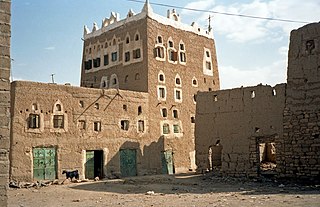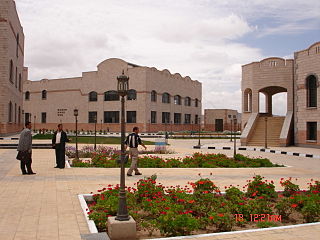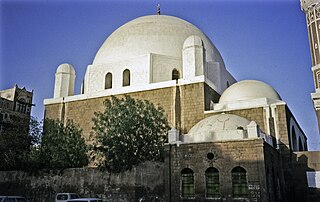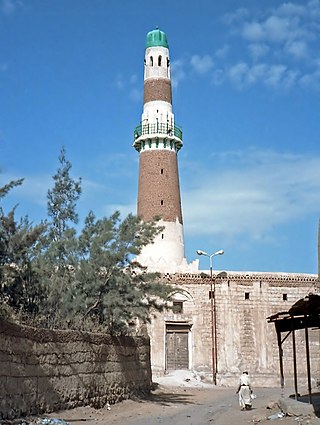Sana'a's Mosques are unique in architecture, and history, they adopted the South Arabian Architecture, unlike the old mosques, the modern mosques are usually built on Modern Arabic Architecture

Zabid is a town with an urban population of around 52,590 people, located on Yemen's western coastal plain. It is one of the oldest towns in Yemen, and has been a UNESCO World Heritage Site since 1993. However, in 2000, the site was placed on the List of World Heritage in Danger. The town was the capital of several ruling dynasties in Yemen over many centuries.

Saada, located in the northwest of Yemen, is the capital and largest city of the governorate bearing the same name, as well as the administrative seat of the eponymous district. The city lies in the Serat (Sarawat) mountains at an altitude of approximately 1,800 meters. As of 2004, it was the tenth-largest city in Yemen, with an estimated population of 51,870.

Dhamar is a city in south-western Yemen. It is located at 14°33′0″N44°24′6″E, at an elevation of around 2,400 m (7,900 ft).

Sanaa, officially the Sanaa Municipality, is the capital and largest city of Yemen. The city is the capital of the Sanaa Governorate, but is not part of the governorate, as it forms a separate administrative unit. According to the Yemeni constitution, Sanaa is the capital of the country, although the seat of the Yemeni government moved to Aden, the former capital of Democratic Yemen, in the aftermath of the Houthi occupation. Aden was declared the temporary capital by then-president Abdrabbuh Mansur Hadi in March 2015.

Al-Saleh Mosque is a modern mosque in Sana'a that is the largest in Yemen. It lies in the southern outskirts of the city, south of the Al Sabeen Maternal Hospital. Originally named "Al Saleh Mosque", it was inaugurated in November 2008 by Yemeni President Ali Abdullah Saleh. The mosque, 27,300 square metres (294,000 sq ft) in size, has a central hall that is 13,596 square metres (146,350 sq ft) with an occupancy capacity of 44,000. The building cost nearly US$60 million to construct. Open to non-Muslims, the mosque is frequented by tourists, and promotes moderate Islam.
Topics related to Yemen include:

The Old City of Sanaʽa is a recognised UNESCO World Heritage Site in the Amanat Al Asimah Governorate, Yemen. As of 2003, the district had a population of 63,398 inhabitants. The old fortified city has been inhabited for more than 2,500 years and contains many intact architectural sites. The oldest, partially standing architectural structure in the Old City of Sanaʽa is Ghumdan Palace. The city was declared a World Heritage Site by the United Nations in 1986. Efforts are underway to preserve some of the oldest buildings some of which, such as the Samsarh and the Great Mosque of Sanaʽa, is more than 1,400 years old. Surrounded by ancient clay walls that stand 9–14 metres (30–46 ft) high, the Old City contains more than 100 mosques, 12 hammams (baths), and 6,500 houses. Many of the houses resemble ancient skyscrapers, reaching several stories high and topped with flat roofs. They are decorated with elaborate friezes and intricately carved frames and stained-glass windows.

Ghumdan Palace, also Qasir Ghumdan or Ghamdan Palace, is an ancient fortified palace in Sana'a, Yemen, going back to the ancient Kingdom of Saba. All that remains of the ancient site of Ghumdan is a field of tangled ruins opposite the first and second of the eastern doors of the Jami‘ Al Kabeer Mosque. This part of Sana'a forms an eminence which is known to contain the debris of ancient times. The place is located on the extreme southeastern end of Sanaa's old walled city, al-Qaṣr, just west of where the Great Mosque of Sana'a was later built, and is part of the UNESCO World Heritage Site of the Old City of Sana'a. It is sometimes referred to as Ghumdan Tower.
The Al Shohada Mosque is a mosque in Sana'a, Yemen. It lies to the south of the ancient Great Mosque of Sana'a and Ghumdan Palace., between the Yemeni military defense complex and Ashohada Cemetery.

The Great Mosque of Sana'a is an ancient mosque in Sana'a, Yemen, and one of the oldest mosques in the world. The mosque is said to have been founded in the early Islamic period, suggested to be in 633. While the precise date of construction is unknown, the earliest recorded renovations occurred under Caliph al-Walid I in the early 8th century, implying a possible earlier date of construction. The mosque was reportedly built in part from spolia from the Himyarite-era Ghumdan Palace and from the Axumite Christian Church of al-Qalis that formerly occupied the site. The Great Mosque is the largest and most notable of over one hundred mosques in the Old City of Sana’a.
The Albolaily Mosque is a mosque in Sana'a, Yemen. It lies to the southwest of the Al Shohada Mosque, near Sana'a Fish Market.

Bakiriyya Mosque is a mosque constructed in Sana'a around 1596–97 by the Ottoman governor of Yemen, Hasan Pasha. The mosque fell into disrepair after the Ottomans were driving out of Yemen in 1626 but was fully restored when the Ottomans recaptured Sana'a in 1878.

Talha Mosque or Qubbat Talha, one of the oldest mosques in Sana'a (Yemen), was built by order of the Ottoman Wali Hadji Mehmed Pasha from 1619 to 1620, during the first Ottoman occupation. The minaret was built at the same time.

The 2015 Sana'a mosque bombings were four suicide attacks targeting two mosques on 20 March 2015 in Sana'a, Yemen.
The following is a timeline of the history of the city of Sana'a, Yemen.

Bab al-Yaman is the main gate of Old Sanaa's old fortified wall, on the southern extremity of the walled city. Its current appearance dates to the 17th century, having been designed by Sam the son of Noah. Today, it is the most ornate of the gates of Sana's Old City. Passengers travelling southward, en route to Ma'bar and Dhamar, would depart from this gate.

The Mosque of the Dome of the Mahdi or Al-Mahdi Mosque is one of the historical mosques in the historic old city of Sana'a, Yemen. It forms a part of UNESCO World Heritage Site Old City of Sana'a. It is located in the Al-Kareem Al-Mahdi neighborhood in the western Sarar district. It was built in 1651 by the order of Imam Mahdi Abbas bin Mansour. The tomb was built after the death of Imam Mahdi Abbas in 1768.

Al-Hadi Mosque or Al-Imam Al-Hadi Mosque is one of the historical mosques of the ancient city of Sa'ada, Yemen. It is located east–west of the city, was built in around 897 C.E., and is named after Imam Yahya Bin Al-Hussein, the founder of the state of Imams of Yemen. The mosque became the oldest place for the teaching of Zaidi maddhab in the Arabian Peninsula.
On 24 September 2015, a double suicide bombing was carried out by Islamic State at a mosque in Sana'a, Yemen, killing at least 25 people.